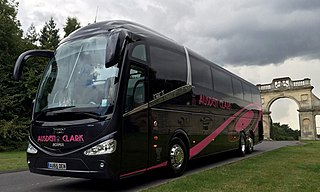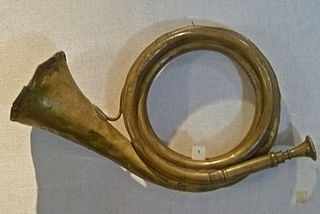
A post office is a public facility and a retailer that provides mail services, such as accepting letters and parcels, providing post office boxes, and selling postage stamps, packaging, and stationery. Post offices may offer additional services, which vary by country. These include providing and accepting government forms, and processing government services and fees. The chief administrator of a post office is called a postmaster.

A coach is a type of bus built for longer distance service, in contrast to transit buses that are typically used for shorter journeys within a single metropolitan region. Often used for touring, intercity, and international bus service, coaches are also used for private charter for various purposes.

A stagecoach is a four-wheeled public transport coach used to carry paying passengers and light packages on journeys long enough to need a change of horses. It is strongly sprung and generally drawn by four horses although some versions are drawn by six horses.

Cobb & Co was the name used by several independent Australian coach businesses. The first company to use 'Cobb & Co' was established in 1853 by American Freeman Cobb and his partners. The name grew to great prominence in the late 19th century, when it was carried by many stagecoaches carrying passengers and mail to various Australian goldfields, and later to regional and remote areas of the Australian outback. The same name was used in New Zealand and Freeman Cobb used it in South Africa.

A pillar box is a type of free-standing post box. They are found in the United Kingdom and its associated the Crown Dependencies and British Overseas Territories, and, less commonly, in many members of the Commonwealth of Nations such as Cyprus, India, Gibraltar, Hong Kong, Malta, New Zealand and Sri Lanka, as well as in the Republic of Ireland. Pillar boxes were provided in territories administered by the United Kingdom, such as Mandatory Palestine, and territories with agency postal services provided by the British Post Office such as Bahrain, Dubai, Kuwait and Morocco. The United Kingdom also exported pillar boxes to countries that ran their own postal services, such as Argentina, Portugal and Uruguay.

A Travelling Post Office (TPO) was a type of mail train used in Great Britain and Ireland where the post was sorted en route, used from 1830 to 1996, with non-TPO mail trains ending in 2024.

Dublin 2, also rendered as D2 and D02, is a historic postal district on the southside of Dublin, Ireland. In the 1960s, this central district became a focus for office development. More recently, it became a focus for urban residential development. The district saw some of the heaviest fighting during Ireland's Easter Rising.

An intercity bus service or intercity coach service, also called a long-distance, express, over-the-road, commercial, long-haul, or highway bus or coach service, is a public transport service using coaches to carry passengers significant distances between different cities, towns, or other populated areas. Unlike a transit bus service, which has frequent stops throughout a city or town, an intercity bus service generally has a single stop at one location in or near a city, and travels long distances without stopping at all. Intercity bus services may be operated by government agencies or private industry, for profit and not for profit. Intercity coach travel can serve areas or countries with no train services, or may be set up to compete with trains by providing a more flexible or cheaper alternative.

The post horn is a valveless cylindrical brass instrument with a cupped mouthpiece. The instrument was used to signal the arrival or departure of a post rider or mail coach. It was used by postilions of the 18th and 19th centuries.

Parcel post is a postal service for mail that is too heavy for normal letter post. It is usually slower than letter post. The development of the parcel post is closely connected with the development of the railway network which enabled parcels to be carried in bulk, to a regular schedule, and at economical prices. Today, many parcels also travel by road and international shipments may travel by sea or airmail.

A horse-drawn vehicle is a piece of equipment pulled by one or more horses. These vehicles typically have two or four wheels and were used to carry passengers or a load. They were once common worldwide, but they have mostly been replaced by automobiles and other forms of self-propelled transport but are still in use today.

Enfield, also known as Innfield, is a town in south County Meath, Ireland, situated between Kilcock and Kinnegad and very close to the border with County Kildare. The town is on the Dublin-Sligo railway line. It is located on the R148 regional road, formerly the N4 national primary road connecting Dublin to Connacht.
A postbus is a public bus service that is operated as part of local mail delivery as a means of providing public transport in rural areas with lower levels of patronage, where a normal bus service would be uneconomic or inefficient. Postbus services are generally run by a public postal delivery company and combine the functions of public transport and mail delivery and collection. A standard passenger fare is payable to the driver or mail carrier.

Ballyjamesduff is a town in County Cavan, Ireland. A former market town, it was the winner of the 1966 and 1967 Irish Tidy Towns Competition.

Pretty Pine is a community in the central part of the Riverina and situated about 17 kilometres south of Wanganella and 18 kilometres north-west of Deniliquin.

PostAuto Switzerland, PostBus Ltd. (known as PostAuto Schweiz in Swiss Standard German, CarPostal Suisse in Swiss French, AutoPostale Svizzera in Swiss Italian, and AutoDaPosta Svizra in Romansh is a subsidiary company of the Swiss Post, which provides regional and rural bus services throughout Switzerland, and also in France, Germany, and Liechtenstein.

John Palmer of Bath was a theatre owner and instigator of the British system of mail coaches that was the beginning of the great British post office reforms with the introduction of an efficient mail coach delivery service in Great Britain during the late 18th century. He was Mayor of Bath on two occasions and Comptroller General of the Post Office, and later served as Member of Parliament for the constituency of Bath between 1801 and 1807.

Packet boats were medium-sized boats designed for domestic mail, passenger, and freight transportation in European countries and in North American rivers and canals, some of them steam driven. They were used extensively during the 18th and 19th centuries and featured regularly scheduled service. Steam driven packets were used extensively in the United States in the 19th century on the Mississippi and Missouri rivers, supplying and bringing personnel to forts and trading posts.

The General Post Office (GPO) was the state postal system and telecommunications carrier of the United Kingdom until 1969. Established in England in the 17th century, the GPO was a state monopoly covering the dispatch of items from a specific sender to a specific receiver ; it was overseen by a Government minister, the Postmaster General. Over time its remit was extended to Scotland and Ireland, and across parts of the British Empire.

A stage station or relay station, also known as a staging post, a posting station, or a stage stop, is a facility along a main road or trade route where a traveller can rest and/or replace exhausted working animals for fresh ones, since long journeys are much faster with fewer delays when using well fed and rested mounts. Stage is the space between the places known as stations or stops — also known in British English as posts or relays.
























